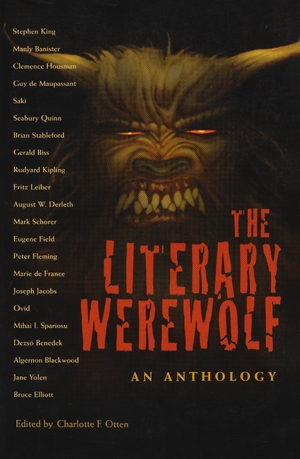Description
Here is a werewolf anthology that uncovers new terrain. Its stories span centuries. Its storytellers, from Stephen King to Saki, de Maupassant to Kipling, Seabury Quinn to Ovid, are eclectic. Its premise delves deeper into its subject than previous, often sensational, collections.
The Literary Werewolf is arranged into ten story groups based on like human needs for animal transformation. Within its pages waits the werewolf who is Erotic . . . Rapacious . . . Supernatural . . . Victimized . . . Avenging . . . Guilty . . . Unabsolved . . . and Voluntary. Each cluster of tales provides unique insights into varied aspects of the human psyche by examining psychological, physical, moral, spiritual, medical, supernatural, and philosophical facets of human/werewolf transmut11tion. Thus, the author sheds spellbinding light on murky impulses lurking beneath the surface of human consciousness.
Table of Contents
Introduction
SECTION I: Medical Cases, Diagnoses, Descriptions
1. A Case of Lycanthropy
Haivey A Rosenstock and Kenneth R Vincent, American Journal of Psychiatry, 1977
2. Lycanthropy Revisited
Frida G. Surawicz and Richard Banta, Canadian Psychiatric Association Journal, 1975
3. Admirable Histories
I. Goulart, Admirable and Memorable Histories, 1607
4. Diseases of the Mind
Robert Burton, Anatomy of Melancholy, 1621
5. A Treatise
Robert Bayfield, A treatise De Morborum Capitis Essentiis & Prognosticis, 1663
SECTION II: Trial Records, Historical Accounts, Sightings
6. A Wolf Which Conversed with a Priest
Giraldus Cambrensis, Topographia Hibernica, 1187
7. Jean Grenier, a French Werewolf
Retold by Sabine Baring-Gould, 1603
8. Stubbe Peeter
Original trial transcript, 1590
9. Of the Metamorphosis of Men into Beasts
Henri Boguet, Discours des Sorciers, 1590
10. British Werewolves
Elliott O’Donnell, 1912
SECTION III: Philosophical and Theological Approaches to Metamorphosis
11. Whether Witches Can By Some Glamour Change Men into Beasts
Heinrich Kramer and James Sprenger, The Malleus Malefkarum, 1486-87
12. Of Transformations
Reginald Scot, The Discoverie of Witchcraft, 1584 115
13. Men-Woolfes
James I, Daemonologie, 1597
14. Spirits and Devils
John Deacon and John Walker, Dialogicall Discourses of Spirits and Divils, 1601
SECTION IV: Critical Essays on Lycanthropy
Anthropology
15. Shape-changing in the Old Norse Sagas
H. R. Ellis Davidson
History
16. Witchcraft in France and Switzerland
E. William Monter
17. The Scientific Status of Demonology
Stuart Clark
Medicine
18. On Porphyria and the Aetiology of Werwolves
L. lllis
19. The Medical Origins of the European Witch Craze: A Hypothesis
Leland L Estes 200
SECTION V: Myths and Legends
20. Lycaon and Jupiter
Ovid, Metamorphoses ( 43 B. C.–A. D. 18)
21. Niceros’s Story
Petronius, The Satyricon (1st century A. D.)
22. Arthur and Gorlagon
Rawlinson MS. (14th century)
23. The Lay of the Were-Wolf
Marie de France (1170?)
24. The Werewolf
Eugene Field (1911)
25. “The Other Side”: A Breton Legend
Eric Stenbock (1893)
SECTION VI: Allegory
26. The Were-Wolf
Clemence Housman (1896)
About the Author
Charlotte F. Otten is professor emerita of English at Calvin College, Grand Rapids, Michigan. She is the author of A Lycanthropy Reader: Werewolves in Western Culture, also published by Syracuse University Press.




